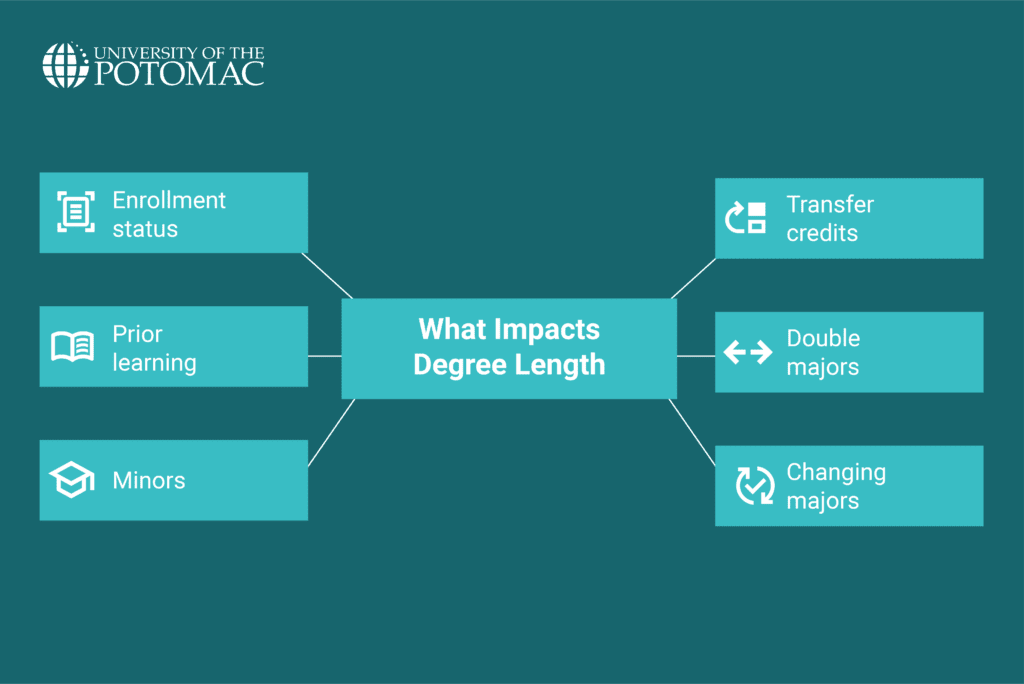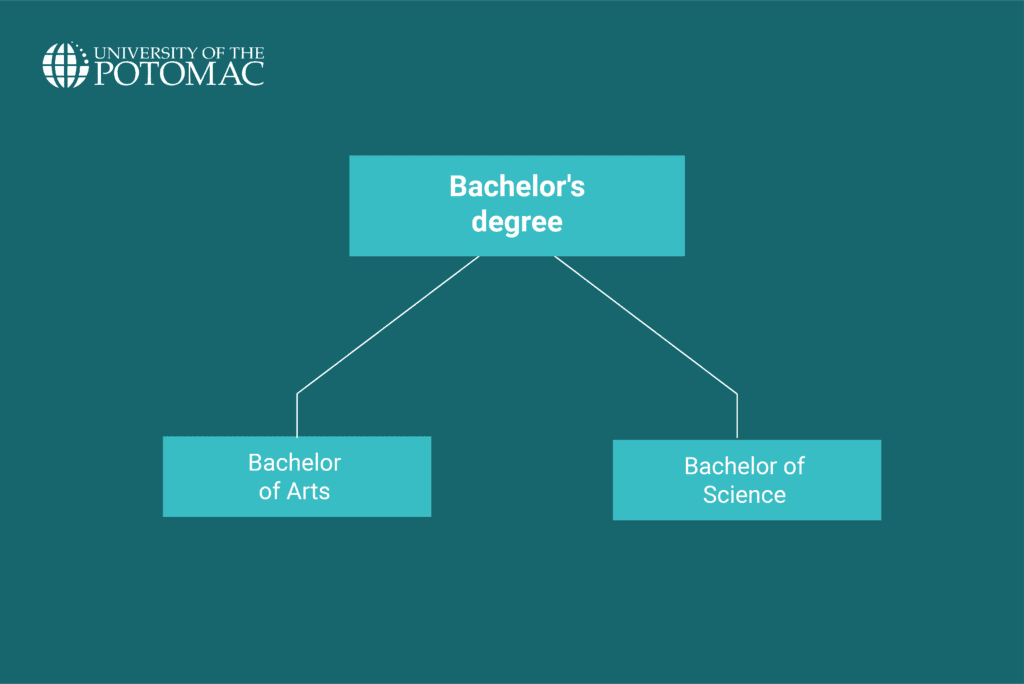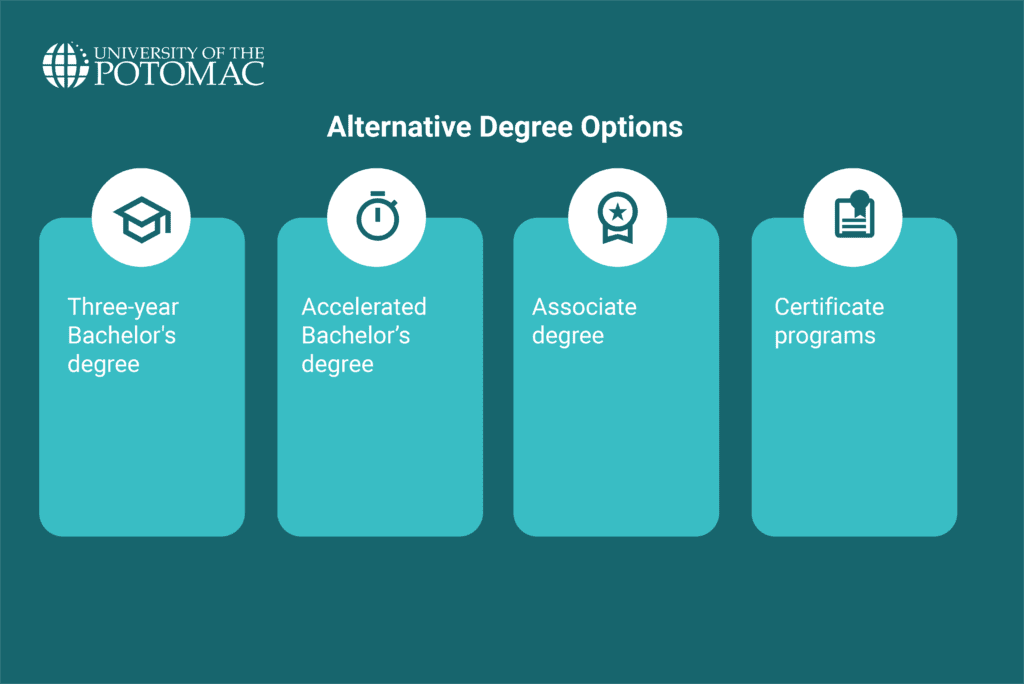Key Takeaways
- It normally takes four years of full-time study to earn a bachelor’s degree.
- Factors like part-time enrollment, transfer credits, and changing or adding majors can shorten or extend that timeline.
- Alternative options to the traditional bachelor’s degree include three-year versions, accelerated programs, associate degrees, or certificate programs.
Time is one of the most valuable things in life, and choosing how you spend it is one of the most important decisions you’ll ever make.
That said, some things are worth that investment—education, for example. Granted, as a kid, you don’t have much of a choice—most U.S. states require you to stay in school until you’re 16 or 18. But after high school, it’s up to you: will you keep investing your time in learning?
As the next step after high school, one of the first things you should understand is how many years is a bachelor’s degree?
How Many Years Is a Bachelor’s Degree?
In the U.S., a traditional bachelor’s degree is designed to be completed over the course of four academic years of full-time study. That generally breaks down to 120 to 130 credit hours that are spread across eight semesters.
Therefore, the answer, in most cases, is four years. This timeline assumes steady progress, meaning the student takes a full course load, passes their classes, and follows their program’s recommended sequence of courses.
Factors That Affect How Long a Bachelor’s Degree Takes

The actual time required to complete a bachelor’s degree can vary depending on a number of factors. Some of them include:
Full-time vs. part-time enrollment
The traditional four-year path assumes full-time enrollment. Thus, if these students continue to make steady progress and do not take breaks, they usually graduate on time.
However, students can follow different schedule choices. There are also many students who choose to enroll part-time in their bachelor’s programs. As they work toward their degree, they frequently balance jobs, families, or other obligations; as a result, they typically need to enroll in fewer classes each semester. This impacts the degree timeline, stretching it to five, six, or even more years.
There certainly are some benefits of part-time study, namely the flexibility. But there are also clear disadvantages because it makes the graduation process longer. There can also potentially be more difficulty accessing financial aid or course offerings, as these are often designed for full-time students.
Transfer credits and prior learning
Many students transfer from community colleges or other colleges and universities, bringing previously earned credits with them. Logically, they’re a step ahead in fulfilling their degree requirements. The credits can count toward general education, electives, or even major requirements—thus helping you save time and graduate early.
In addition, some universities, including ours—the University of the Potomac—offer Prior Learning Assessments (PLA) or credit for work experience, military service, or professional certifications. This way, we allow students to demonstrate the knowledge they’ve gained outside the classroom and earn credit toward their degree.
It’s always important to check your preferred school’s transfer credit policies since not all credits are guaranteed to transfer, and some may only apply as electives.
Double majors and minors
Pursuing a double major means completing the requirements for two distinct degree programs. This often results in additional semesters, especially if the two majors don’t share many overlapping courses.
Similarly, adding one or more minors to your college major can extend your timeline—especially if the minor is in a completely unrelated field. Students choosing to declare a minor may find themselves needing to take extra electives or prerequisite courses that weren’t part of their original plan.
It’s best to map out your degree plan early and meet with an academic advisor in order to make sure that you can realistically complete the additional coursework without unnecessary delays.
Changing majors
It’s common for students to change their minds about their field of study. In fact, around 80% of college students switch their majors at least once.
However, changing majors usually comes with setbacks in the form of delays. In some cases, previously completed courses may not count toward the new major’s requirements, which can lead to extra semesters needed to catch up and stay on track for graduation.
To minimize such delays, you should:
- Speak with an advisor before making the switch.
- Choose a new major that overlaps with your previously completed courses.
- Consider taking summer or winter session classes to stay on track.
Types of Bachelor’s Degrees

As you explore your college options, you’ll likely notice that, among the types of bachelor’s degrees available, most are usually either Bachelor of Arts (BA) or Bachelor of Science (BS).
BA degree programs typically focus on subjects within the humanities, social sciences, and liberal arts. On the other hand, the BS ones are generally more technical and specialized.
At the University of the Potomac, we provide another important and practical classification of bachelor’s degree options based on where you are in your academic journey.
We offer two types of bachelor’s degree programs to support different student needs:
- Lower division support courses, designed for students who are just starting their college education.
- Upper-division 18-month programs, ideal for students who already meet the prerequisites and are ready to focus on their chosen field.
Each bachelor’s degree program at Potomac includes a core set of courses that lay the foundation for professional work in that field. This is followed by specialized courses that allow students to develop their expertise and prepare for long-term career success. The combination aims to help students achieve academic, personal, and professional growth that continues beyond graduation.
Alternative Degree Options

Even though many students still pursue the conventional four-year bachelor’s degree after graduating from high school, there are other ways to succeed. For those who want to advance their education but may not want—or be able—to commit to a full bachelor’s program right away, some alternative degree options worth exploring include:
Interested in pursuing a degree?
Fill out the form and get all admission information you need regarding your chosen program.
This will only take a moment.
Message Received!
Thank you for reaching out to us. We will review your message and get right back to you within 24 hours.
If there is an urgent matter and you need to speak to someone immediately you can call at the following phone number:
- We value your privacy.
Three-year Bachelor’s degree
Some universities provide three-year bachelor’s degree models. These programs are often more focused, with fewer general education requirements and more direct entry into the major field of study from the beginning.
While challenging, a three-year bachelor’s degree can reduce tuition costs and help students enter the workforce sooner.
Accelerated Bachelor’s degree
Like the three-year path, accelerated degree programs are designed for students who want to graduate faster than the traditional four-year timeline. However, these programs are often tailored for adult learners, transfer students, or those returning to school with prior credits or professional experience.
Accelerated programs usually run year-round, with shorter terms and more intensive coursework per term. This means students take more credits in a condensed time frame—often 18 to 24 months for those entering with prerequisites completed.
Associate degree
If you’re not ready to jump into a bachelor’s program just yet, an associate degree is a great alternative option that can be completed in two years and provide a foundation in general education along with introductory coursework in a specific field.
The key difference between such a degree and a bachelor’s degree lies in depth and duration. The bachelor’s option offers more advanced coursework and leads to a wider range of career opportunities, while an associate degree allows students to enter the workforce earlier in roles that require less specialization. Alternatively, after obtaining your associate’s degree, you could transition into a bachelor’s program with the credits you earn.
At Potomac, we offer various associate’s degree options as we recognize its benefits, especially for students who need flexibility or want to test the waters before committing to a four-year degree. It’s a smart way to move forward without feeling locked in from the start.
Certificate programs
Certificate programs are an excellent alternative for students focused on quickly building specific skills. These programs are short-term—typically completed in a few months to a year—and career-focused.
The best certificate programs are those that focus on a particular job skill or industry credential and help students upskill, reskill, or launch a new career.
Certificate programs at the University of the Potomac can be especially helpful in network security, business, project management, early childhood development, and office technology, among other areas.
Conclusion
Ultimately, how long a bachelor’s degree takes is much less important than how much it means to you, and that value only increases if you pursue it at a university that encourages you to achieve your goals. When you’re studying at the University of the Potomac, time goes by faster than you think.
We offer a range of bachelor’s degree programs designed to fit your aspirations. So, explore them and take this step with us—every day will feel like progress.
Frequently Asked Questions
Is it realistic to complete a bachelor’s degree in 3 years?
Some programs are structured to be completed in that time frame, and even traditional four-year degrees can be finished in three years with careful planning, a heavier course load, and enrollment in summer or accelerated terms.
Is it possible to graduate with a bachelor’s degree in 2 years?
Graduating in two years can be possible for students with significant transfer credits, prior learning, or those enrolled in an accelerated program designed for that pace.
What degree is 8 years of college?
Spending eight years in college typically refers to earning a bachelor’s degree followed by a doctoral or professional degree, such as an MD, JD, or PhD.










